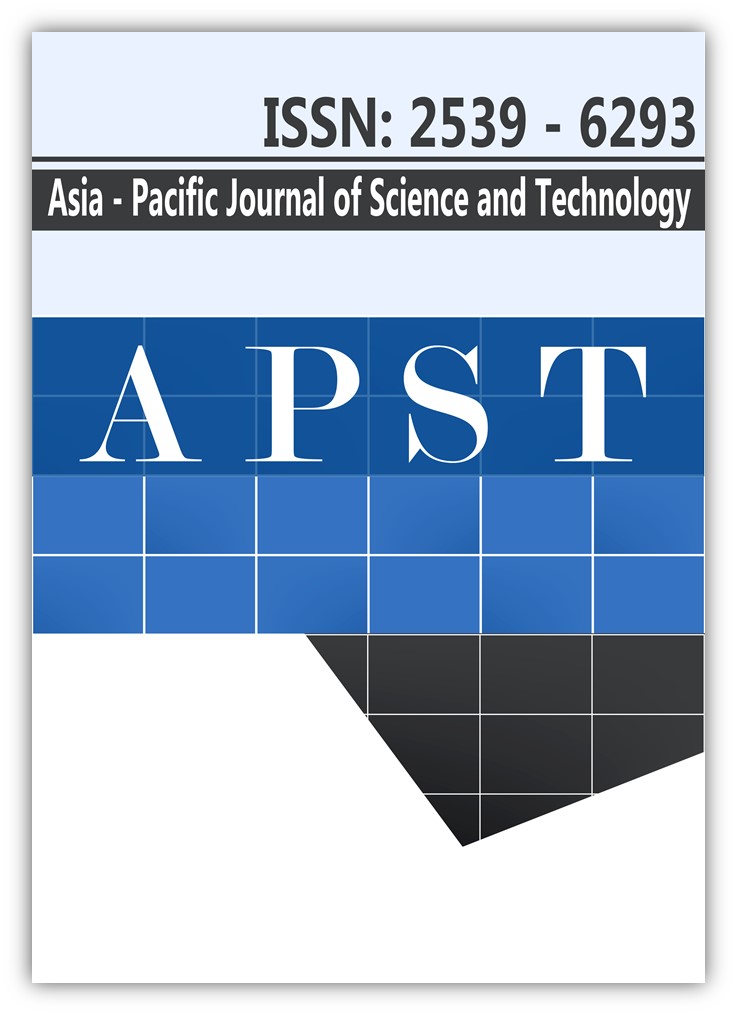Metabolic profiles analysis and DPPH radical-scavenging assay of ‘Nam Dok Mai’ mango wine during fermentation
Main Article Content
Abstract
The ‘Nam Dok Mai’ mango, a famous fruits known worldwide, is produced and consumed extensively. However, mango is a climacteric fruit with a short shelf-life. Therefore, wine production is an alternative procedure, which can be used to process low-quality mangoes. The metabolic profiles of mango wine during fermentation would present a broadening of low molecular compositions, which might improve the production and quality of mango wine. Using the metabolomic approach, fifty-six peaks could be identified, accounting for approximately 40% of all metabolites. Based on the metabolites found in mango wine, Principal Component Analysis (PCA) coupled with Agglomerative Hierarchical Clustering Analysis (AHC) analysis was processed to differentiate all samples. Oleic acid, linoleic acid (ω-6), and α-linolenic acid (ω-3) were significantly decreased during the fermentation periods. The most abundant phytosterols, found in ‘Nam Dok Mai’ mango wine, were β-sitosterol, campesterol, and stigmasterol. A decrease in all phytosterols was also found during fermentation. Regarding the polar metabolites, most of the sugars, including sucrose, glucose, and fructose, were depleted by wine yeast during their alcoholic metabolism. Conversely, organic acids, such as malic acid and citric acid, were slightly increased during the fermentation process due to aerobic glycolysis channels. The antioxidant activity in mango wine during fermentation periods was not different.
Article Details
References
[2] Reddy LVA, Reddy OVS, Joshi VK. Production of wine from mango fruit: a review. Int J Food Ferment Tech. 2014;4(1):33-45.
[3] Limwiwattana D, Tongkhao K, Na Jom K. Effect of sprouting temperature and air relative humidity on metabolic profiles of sprouting black gram (Vigna mungo L.). J Food Process Pres. 2016;40(2):306-315.
[4] Sriwimon W, Boonsupthip W. Utilization of partially ripe mangoes for freezing preservation by impregnation of mango juice and sugars. LWT-Food Sci Tech. 2011;44:375-383.
[5] Li X, Chan LJ, Yu B, Curran P, Liu SQ. Fermentation of three varieties of mango juices with a mixture of Saccharomyces cerevisiae and Williopsis saturnus var. mrakii. Int J Food Microbiol. 2012;158(1):28-35.
[6] Na Jom K, Frank T, Engel KH. A metabolite profiling approach to follow the sprouting process of mung beans (Vigna radiata). Metabolomics. 2011;7(1):102-117.
[7] Chanput W, Krueyos N, Ritthiruangdej P. Anti-oxidative assays as markers for anti-inflammatory activity of flavonoids. Int Immunopharmacol. 2016;40:170-175.
[8] Pinu F, Edwards P, Gardner R, Villas-Bôas S. Nitrogen and carbon assimilation by Saccharomyces cerevisiae during Sauvignon blanc juice fermentation. FEMS Yeast Res. 2014;14:1206-1222.
[9] Ribéreau-Gayon P, Glories Y, Maujean A, Dubourdieu D. Handbook of enology, the chemistry of wine: stabilization and treatments. Hoboken (NJ): John Willey and Son; 2006.
[10] Vilela C, Santos SAO, Oliveira L, Camacho JF, Cordeiro N, Freire CSR, et al. The ripe pulp of Mangifera indica L.: a rich source of phytosterols and other lipophilic phytochemicals. Food Res Int. 2013;54(2):1535-1540.
[11] Ruggiero A, Vitalini S, Burlini N, Bernasconi S, Iriti M. Phytosterols in grapes and wine , and effects of agrochemicals on their levels. Food Chem. 2013;141(4):3473-3479.
[12] Ribéreau-Gayon P, Glories Y, Maujean A, Dubourdieu D. Handbook of nology: the microbiology of wine and vinifications. Hoboken (NJ): John Willey and Son; 2006.
[13] Camarasa C, Grivet JP, Dequin S. Investigation by 13C-NMR and tricarboxylic acid (TCA) deletion mutant analysis of pathways of succinate formation in Saccharomyces cerevisiae during anaerobic fermentation. Microbiology. 2003;149(9):2669-2678.
[14] Portu J, López R, López-Alfaro I, González-Arenzana L, Santamaría P, Garde-Cerdán T. Amino acid content in red wines obtained from grapevine nitrogen foliar treatments: consumption during the alcoholic fermentation. Wine St. 2014;3:4475.
[15] Varakumar S, Kumar YS, Reddy OVS. Carotenoid composition of mango (Mangifera indica L.) wine and its antioxidant activity. J Food Biochem. 2011;35(5):1538-1547.
[16] Kun S, Rezessy-Szabó JM, Nguyen QD, Hoschke Á. Changes of microbial population and some components in carrot juice during fermentation with selected Bifidobacterium strains. Process Biochem. 2008;43(8):816-821.
[17] Ningrum A, Minh NN, Schreiner M. Carotenoids and orisoprenoids as carotenoid degradation products in pandan leaves (Pandanus amaryllifolius Roxb.). Int J Food Prop. 2015;18(9):1905-1914.


